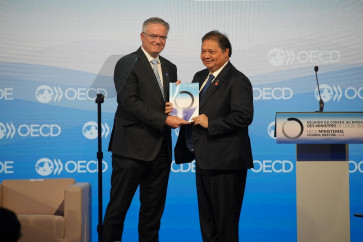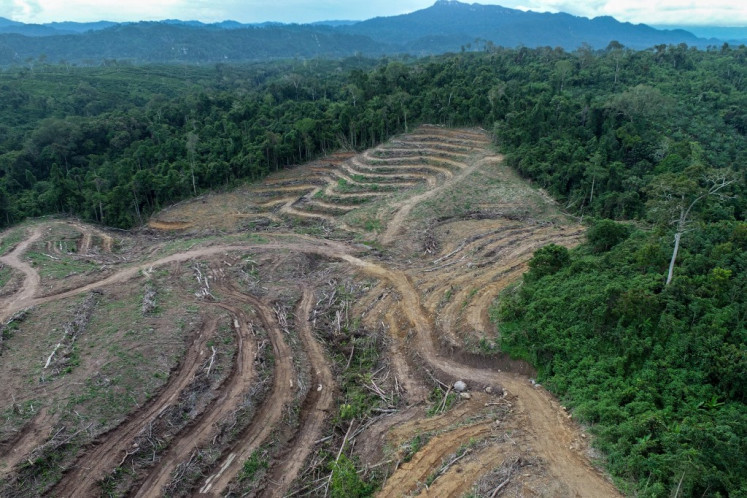Popular Reads
Top Results
Can't find what you're looking for?
View all search resultsPopular Reads
Top Results
Can't find what you're looking for?
View all search resultsMiners suffer as commodity prices continue free fall
The country’s mineral miners, including tin producer PT Timah and nickel producer PT Vale Indonesia, continued to face setbacks in their businesses in the first semester of the year as a result of falling commodity prices following the global economic slowdown
Change text size
Gift Premium Articles
to Anyone
T
he country’s mineral miners, including tin producer PT Timah and nickel producer PT Vale Indonesia, continued to face setbacks in their businesses in the first semester of the year as a result of falling commodity prices following the global economic slowdown.
State-owned Timah reported consolidated revenue of Rp 4.13 trillion (US$437 million) during the January-to-June period of the year, 15 percent lower compared to Rp 4.83 trillion over the same period last year. The decline was particularly due to lower production and delivery, a move that the company chose to overcome with the falling sales price of tin.
Timah’s refined tin production reached 14,984 metric tons in the first semester of the year, a 19 percent slump from 18,455 metric tons over the same period last year. The company sold 17,236 metric tons of refined tin during the first six months of the year, a slight 1 percent drop compared to 17,457 metric tons during the same period last year.
“Our production in the first semester of the year was lower than our capacity. However, the company doesn’t want to boost production if it will sell the products at low prices,” Timah corporate secretary Agung Nugroho said on Monday.
Timah’s refined average tin selling price was $22,565 per metric ton in the first half of the year, falling 24 percent compared to $29,541, year-on-year. The refined tin price on the London Metal Exchange (LME) — the main benchmark of the world’s tin price — stood at $21,791 per ton in the first half of the year, 25 percent lower than in the same period last year. The highest level of refined tin on the LME was $25,650 and the lowest $18,375 per metric ton.
“In the first semester, we only sold refined tin for long term contracts. We didn’t want to sell on the spot market,” Agung said, adding that up to 60 percent of the company’s total sales were to Japan, Korea and Taiwan. About 30 to 35 percent of the company’s sales went to Germany while the remainder went to the United States.
Timah and several other tin producers have been trying to increase the tin price, including halting tin exports late last year. The companies then supported by the Commodity Futures Trading Supervisory Board (Bappebti), supported by the Indonesia Commodities and Derivatives Exchange (ICDX), established a tin futures market called INATIN. The move was an attempt to set a tin price to be the alternative to the LME’s.
However, INATIN had no significant influence.
“So far, only Timah has become a seller among the market members of only about five companies. We still trade our tin, but never reached a deal price,” Agung said.
Timah booked Rp 336.7 billion in net profit in the first half of the year, a 50 percent drop compared to Rp 684.84 billion during the same period last year.
Similar to Timah’s poor performance, Vale booked a 40 percent drop in sales to $425.38 million in the first half of the year compared to $715.38 million year-on-year.
The company’s production volume was 28,993 metric tons of nickel matte, 17 percent lower compared to 35,100 metric tons over the same period last year. Vale’s nickel matte deliveries reached 28,763 metric tons in the first semester, an 18 percent drop compared to 35,127 metric tons during the same period last year.
“The LME’s nickel price fluctuated unfavorably throughout 2012, particularly in the second quarter. The average price in the first half contributed to a reduction in sales,” Vale said in a written statement.
Vale’s average selling price was $13,816 per metric ton in the second quarter of the year, declining by 11 percent from $15,470 per metric ton in the first quarter. In the first half comparison, Vale’s average selling price was down by 28 percent to $14,535 per metric ton from $20,052 in the first half of 2011.
Vale’s net profit plunged 97 percent to $5.52 million in the first half of the year compared to $238.15 million in the same period last year.










